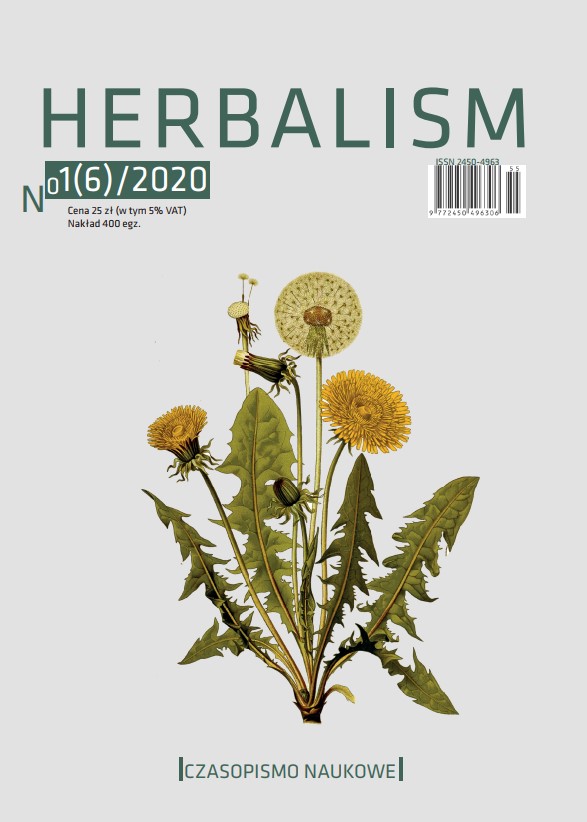Wykorzystanie miodu w zakażeniach
DOI:
https://doi.org/10.12775/HERB.2020.008Palabras clave
miód pszczeli, zakażenia miejscowe, rany, oparzenia, ropnie, owrzodzenia, odleżyny, opatrunki, choroby wewnętrzne, choroby przewodu pokarmowegoResumen
Miód pszczeli odznacza się działaniem przeciwdrobnoustrojowym, przeciwzapalnym, łagodzącym ból, oczyszczającym rany z martwych tkanek, dezodorującym, stymulującym ziarninowanie, przyspieszającym nabłonkowanie oraz wzmacniającym proces bliznowacenia. Dzięki tym właściwościom znalazł zastosowanie w leczeniu zakażeń, zarówno miejscowych, jak i wewnętrznych. W postaci okładów i opatrunków stosowany jest do leczenia ran, oparzeń, ropni i owrzodzeń. Jest także bardzo skuteczny w leczeniu zakażeń niepoddających się terapii preparatami konwencjonalnymi, w tym wywołanych drobnoustrojami opornymi na antybiotyki. Dobre efekty uzyskuje się przy leczeniu miodem ran oparzeniowych, ran odleżynowych, owrzodzeń żylakowych podudzi oraz ran cukrzycowych. Do zalet tego rodzaju leczenia zalicza się: łatwość usuwania opatrunków z powierzchni rany, brak reakcji alergicznych, lepsze przygotowanie ran do operacji chirurgicznych i przeszczepów skóry, krótszą hospitalizację chorych oraz wielokrotnie tańszy proces leczenia w porównaniu do antybiotykoterapii.
Miód wykorzystywany jest również z powodzeniem do leczenia chorób wewnętrznych, szczególnie zakażeń przewodu pokarmowego i układu oddechowego. Dobre efekty uzyskuje się w leczeniu zapalenia żołądka i jelit oraz mukowiscydozy. Na tej podstawie można przyjąć, że miód jest cennym lekiem, który z dobrym efektem stosuje się w terapii chorób miejscowych i wewnętrznych, szczególnie trudnych do leczenia metodami tradycyjnymi.
Citas
Cooper R.A., Molan P.C., Harding K.G., The sensitivity to honey of Gram-positive cocci of clinical significance isolated from wounds, Journal of Applied Microbiology, 2002, 93, s. 857–863.
Subrahmanyam M., Topical application of honey in treatment of burns, British Journal of Surgery, 1991, 78, s. 497–498.
Phuapradit W., Saropala N., Topical application of honey in treatment of abdominal wound disruption, Aust. NZ., Journal of Obstetrics and Gynaecology, 1992, 32 (4), s. 381–384.
Moleenaar M. i wsp., The effect of honey compared to conventional treatment on healing of radiotherapy – induced skin toxicity in breast cancer patients, Acta Oncologica, 2006, 45, s. 623–624.
Güneş U.Y., Eşer I., Effectivenes of a honey dressing for healing pressure ulcers, Journal of Wound Ostomy Continence Nursing, 2007, 34 (2), s. 14–15.
Vanhoof P., Miód na trudno gojące się rany, Pszczelarstwo, 2003, (7), s. 14–15.
Al.-Saeed M., Therapeutic efficacy of conventional treatment combined with manuka honey in the treatment of patients with diabetic foot ulcers: A randomized controlled study, Egyptian Journal of Hospital Medicine, 2013, 53 (10), s. 1064–1071.
Biglari B., Linden P.H., Simon A. i wsp., Use of Medihoney as a non-surgical therapy for chronic pressure ulcers in patients with spinal cord injury, Spinal Cord, 2012, 50, s. 165–169.
Jajris R.D., Crewe B.T., Matzen S.H., Post-bariatric abdominoplasty resulting in wound infection and dehiscence – conservative treatment with medical grade honey: A case report and review of literature, International Journal of Surgery Case Reports, 2016, 20, s. 1–3.
Sioma-Markowska U., Leczenie ran trudno gojących się w ginekologii, Ginekologia i Położnictwo Medical Project, 2011, 4 (22), s. 55–62.
Dunford C.E., Hanano R., Acceptability to patients of a honey dressing for non-healing venous leg ulcers, Journal of Wound Care, 2004, 13 (5), s. 193–197.
Gethin G.T., Cowman S., Conroy R.M., The impact of Manuka honey dressing on the surface and pH of chronic wounds, International Wound Journal, 2008, 5 (2), s. 185–194.
Thamboo A. i wsp., Singleblind study of manuka honey in allergic fungal rhinosinusitis, Journal of Otolaryngology-Head & Neck Surgery, 2011, 40 (3), s. 238–243.
Lin S.M., Molan P.C., Cursons R.T., The controlled in vitro susceptibility of gastrointestinal pathogens to the antibacterial e{ect of manuka honey, European Journal of Clinical Microbiology & Infectious Diseases, 2011, 30, s. 569–574.
Al.-Somal N. i wsp., Susceptibility of Helicobacter pylori to the antibacterial activity of manuka honey, Journal of the Royal Society of Medicine, 1994, 87, s. 9–12.
Keenan J.I. i wsp., Using food to reduce H. pylori – associated inflammation, Phytotherapy Research, 2012, 26, s. 1620–1625.
Hammond E.N., Donker E.S., Antibacterial e{ect of Manuka honey on Clostridium diHcile, BMC Research Notes, 2013, 6, s. 188–193.
Jenkins R. i wsp., A demonstration of the susceptibility of clinical isolates obtained from cystic fibrosis patients to manuka honey, Archives of Microbiology, 2015, 197, s. 597–601.
Descargas
The publisher's shop:
Publicado
Cómo citar
Número
Sección
Licencia

Esta obra está bajo una licencia internacional Creative Commons Atribución-SinDerivadas 4.0.
Stats
Number of views and downloads: 1389
Number of citations: 0



